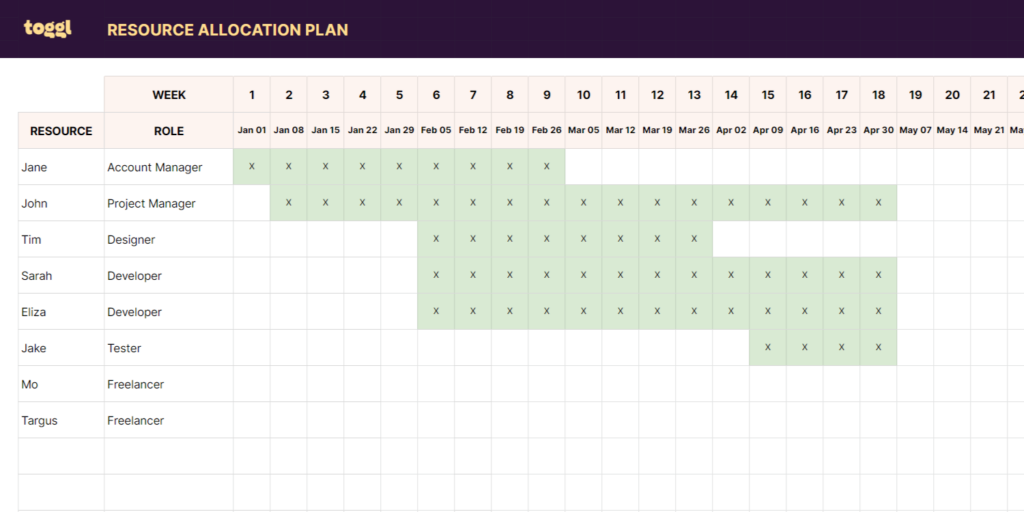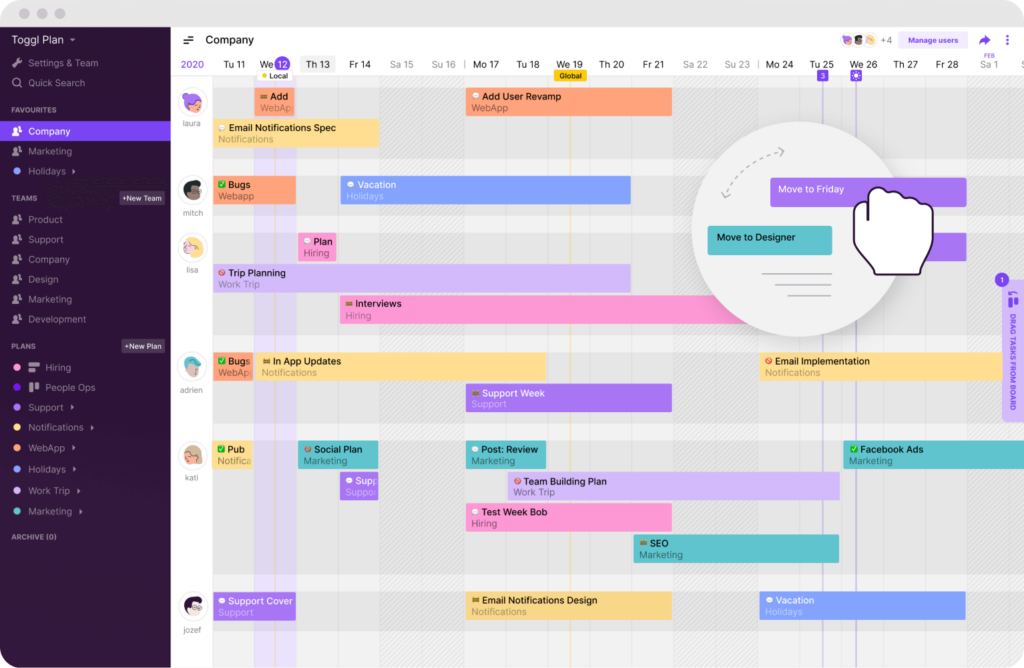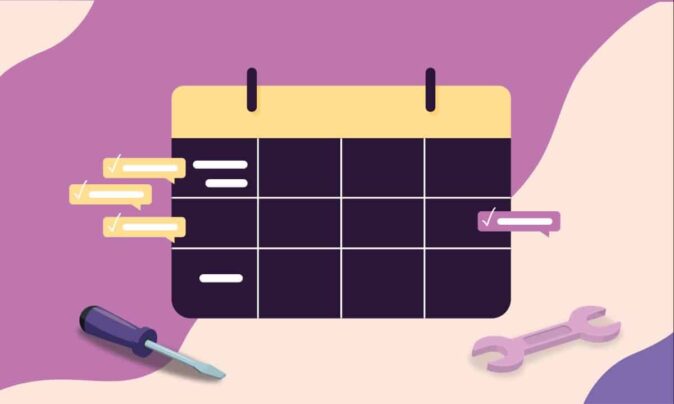Managing resources for projects can be challenging for agency project managers. From keeping track of team schedules to allocating resources, it can be challenging to stay on top of everything and ensure that projects are completed on time and within budget.
This can lead to missed deadlines, budget overruns, and frustrated team members. It’s a constant struggle to keep everything organized and ensure everyone is working on the right tasks at the right time.
But there’s a solution. Effective resource planning allows agencies to manage their team schedule, optimize utilization, and deliver profitable projects.
This article explains everything you need to know about resource planning, from the basics to advanced tips and best practices. By the end of this guide, you’ll have the knowledge you need to balance your team’s workload while staying profitable.
Let’s dive in.
What is resource planning?
Resource planning is identifying, allocating, tracking, and controlling the resources needed to deliver a project profitably while keeping resource usage balanced. It’s an essential aspect of project management, as it helps organizations ensure they have the resources they need to complete their projects on time and within budget.
Resources include people, materials, tools, and financial resources.
Unlike resource capacity planning, which happens at an organizational level, resource planning is done at the project level.
Resource planning vs. resource management
Resource planning and resource management are two closely related activities in project management. They are often used interchangeably.
However, there are some subtle differences.
| Resource planning | Resource management |
|---|---|
| Involves identifying and assigning resources to project tasks to complete a project | Involves tracking and monitoring resources allocated to a project |
| Forward-looking process in the early stages of project planning | Ongoing process during the project’s lifecycle |
| Helps project managers fulfill the resource demands of a project | Helps managers optimize resource utilization and workload |
Resource planning vs. capacity planning
Resource and capacity planning are closely related. But happen at different levels in the organization. Key differences include:
| Resource planning | Resource capacity planning |
|---|---|
| Involves identifying and allocating resources to a project | Involves human resource planning at an organizational level |
| Based on the project scope, WBS, and project schedule | Based on forecasted demand |
| Responsibility of a project manager | Responsibility of people ops department and top management |
Why is resource planning important for agencies?
In agencies, effective resource planning is essential as they:
- Often have multiple projects running simultaneously.
- Account for human factors, including capacity, availability, and expertise
- Ensure that the team is being utilized productively while meeting client expectations
As a result, agencies need help to continue using ad-hoc processes or spreadsheets to keep track of their team’s work. They need a systematic, documented resource planning process. Plus, resource planning software to plan and stay on top of project resource requirements.
Benefits of resource planning
Agencies can benefit immensely from planning their team’s workload. Some of these benefits include:
- Improved project management: It helps agencies better understand resource needs and allocate them effectively. This leads to improved project management and an increased likelihood of projects being completed on time and within budget.
- Increased productivity: It helps agencies ensure that their resources are being used in the most efficient way possible. This leads to better productivity and outcomes.
- Better team collaboration: It helps agencies better understand each team member’s roles and responsibilities and allocate them accordingly. This leads to improved team collaboration.
- Better client management: It helps agencies better understand their clients’ needs and allocate resources accordingly. This leads to improved client management and client satisfaction.
- Improved resource utilization: It helps agencies better understand resource capacity and requirements. This leads to optimal utilization.
- Reduced costs: It helps agencies reduce costs by ensuring that resources are being allocated and utilized productively. This leads to cost savings and better profit margins.
- Better decision-making: It provides agencies with the information and insights they need to make hiring (or layoff) decisions. This leads to better long-term decisions.
Resource planning processes
Making a resource plan involves several key processes, such as:
- identifying and allocating resources
- tracking progress and making adjustments
- and monitoring and controlling resources
In this section, we’ll take a closer look at each of these processes and how they can be applied to agency projects.
Identifying resource needs
Project resources need to be identified early in the planning stage. Project managers can identify resource needs by:
- Define the project scope: First, clearly understand the project scope. This includes understanding the project objectives, deliverables, timelines, and constraints.
- Create a Work Breakdown Structure (WBS): Break down the project into smaller, well-defined deliverables and project tasks. This helps identify the specific resources needed.
- Identify resource requirements: Once the WBS is complete, identify the specific resources needed for each task. Again, these resources can be people, materials, tools, and budget.
For agency projects, people are the most critical resources.
In the third step above, as an agency project manager, you’ll need to understand the skills needed to complete each project task. And then, you’ll be able to identify the skilled resources required.
Resource allocation
Resource allocation is allocating resources to specific tasks within a project. It’s a critical step in project management, as it helps ensure that the right resources are available and optimally used.
Once you’ve identified the resources needed for a project,
- Check resource availability: Look at the availability of resources within the organization. Consider skills, capacity, vacation plans, and current workload for human resources.
- Prioritize resource allocation: You don’t need all the resources throughout the project’s lifecycle. Based on the project’s objectives and deliverables, prioritize when and how resources will be allocated.
- Make hiring decisions: If you need more resources, consider ways to fill resource gaps. Do you need to hire a Full-Time Employee (FTEs)? Or will a freelancer do?
- Book resources: Finally, assign the resources to their respective tasks. Provide a way for other project managers to look at the resource allocation to avoid scheduling conflicts.
Resource management and tracking
Resource management involves monitoring resource utilization and making adjustments as necessary to complete a project successfully.
It’s a critical process in project management because poor utilization leads to loss-making projects. On the other hand, over-utilization leads to overwork and burnout.
According to Aflac, a medical insurance company, close to 60 percent of American workers experience burnout at their jobs.
In either case, as a project manager, you’ll need to re-assess your project resource plan and make adjustments to deliver the project on time without overwhelming your team members with work.
Making a resource plan
A resource plan is a document that outlines the resources needed for a project and how they will be allocated and managed. It serves as a roadmap for the project team, outlining the resources required, when they are needed, and how they will be used.
A resource plan has the following elements:
- Project schedule: A timeline of the project’s tasks and critical milestones
- Requirements: A list of the required people, materials, equipment, and financial resources
- Availability: An overview of the resources available within the organization
- Allocation: A plan outlining what, when, and how resources will be allocated to specific project tasks
- Tracking and management: An overview of how utilization will be measured, tracked, and managed throughout the project
- Hiring plans: A plan to hire external vendors, freelancers or FTEs
Resource planning and management techniques
Resource planning techniques are methods to allocate resources effectively. Some examples include:
- Work Breakdown Structure (WBS): a method to break down a project into smaller, more manageable deliverables and tasks
- Gantt chart timelines: a graphical representation of a project and resource schedules for visual resource planning
- Capacity planning: a technique to meet future resource needs by analyzing current usage and forecasting demand
- Resource leveling: a technique used to prevent the overallocation of resources by delaying or rescheduling tasks as needed
- Resource smoothing: a technique used to avoid the overallocation of resources by delaying project tasks without affecting the finish date
- Resource utilization: a technique to ensure optimum resource usage while keeping workloads balanced
- Resource allocation matrix: a tool or template used to represent how resources are assigned to tasks and projects
Resource planning tools
Resource planning tools are software applications that help project managers manage resources. Depending on your needs, you can use a resource planning tool for:
- Project management: Plan and track projects, tasks, and deadlines assigned to your team members.
- Staffing or capacity planning: Ensure adequate capacity to match forecasted demand.
- Scheduling or shift management: Plan and schedule equipment, tools, materials, and people.
- Workload management: Plan and track the workload of your resources, particularly people, to ensure that no one is over or underworked.
- Budgeting: Track and manage financial resources.
Project resource planning templates
Other than software applications, many Excel or Google Sheets resource planning templates are available online. According to Wellingtone, 35% of project managers use MS Excel to build resource plans.

However, these templates have a few inherent limitations.
- Limited functionality: Templates are typically designed for specific tasks and may have a different level of functionality than dedicated resource management tools.
- Not scalable: Templates are often designed for very small teams and may not be suitable for agencies that manage multiple projects and resources.
- Limited collaboration: Templates are typically used by a single person and may not have built-in collaboration features that a resource management tool has.
- Lacks security: Templates are prone to security risks. A dedicated resource management tool that has inbuilt security and data backup features.
- Data validation issues: Templates don’t have built-in data validation checks. This can lead to inaccuracies, inconsistencies, and poor resource planning.
Project resource planning best practices
Now that you know what it takes to manage resources, let’s look at some resource planning tips.
#1. Document the project resource plan
While documenting the resource plan may seem like a waste of time, it has several advantages. These include:
- Improved communication: A written resource plan helps project managers communicate resource needs to the project team and stakeholders.
- Better tracking: It serves as a baseline for tracking resource allocation and utilization throughout the project.
- Future reference: A documented plan is a reference for future projects and is used to identify best practices and areas for improvement.
- Evidence of billable work: Clients often under-appreciate a project manager’s billable contribution. A document serves as evidence of the work done.
- Compliance: Some location-specific, industry-specific, or enterprise resource planning needs to comply with regulations. This also includes documentation guidelines.
#2. Continually review and adjust the resource plans
Resource planning is an ongoing process in a project’s lifecycle. You’ll need to monitor and optimize resource utilization from project initiation to closure.
Sub-optimal resource utilization can be of two kinds:
- Underutilization: Poor utilization of resources leads to losses. Whether you work on fixed-price or time-and-material-based projects, you’re paying a full salary to your FTEs. If they’re not utilized to the best of their capacity, your agency will struggle to deliver profitable projects.
- Overutilization: At the same time, you don’t want to overwork your employees. Inevitably, this results in poor productivity, stress, and burnout. Overutilization eventually leads to attrition and more considerable hiring costs.
Maintaining this balance requires you to review and adjust your project and resource plans continuously.
#3. Track time irrespective of your revenue model
Agencies often struggle to answer the question—how much billable time should you budget for vs. how much should you aim for in actuality?
Unfortunately, there’s no simple answer. It depends on many factors, including:
- The markup on project and resource costs
- Individual responsibilities of project team members
- Time spend on internal meetings, communication, training, etc.
Marcel Petitpas, who helps agencies become profitable, recommends the following as weekly benchmarks:
| Role | Capacity (hours) | Allocated (%) | Allocated (hours) | Billable (%) | Billable (hours) |
|---|---|---|---|---|---|
| Pure delivery | 40 | 80% | 32 | 70% | 28 |
| Client/project management | 40 | 50% | 20 | 40% | 16 |
| Average | 40 | 70% | 28 | 60% | 24 |
Consider using time tracking software to stay on top of how your team spends their time.
#4. Use resource planning tools
Todo: According to… teams that use project management tools are…Resource planning tools are an essential part of your project management software stack.
In agencies, human resources are critical to delivering projects. Plus, team members often split work hours across multiple projects. Yet many agency project managers rely on rudimentary methods such as spreadsheets for resource planning.
While spreadsheets and project resource planning templates are great for getting started quickly, they fail to help in the long run. Using Excel for resource planning often results in chaos and usually requires face-to-face meetings to resolve. This results in a loss of productivity.
Common resource planning mistakes to avoid
By avoiding common pitfalls, project managers can improve resource planning and increase the chances of project success. Common mistakes include:
- Over-allocation: Booking more than necessary resources can lead to waste and inflated project costs.
- Under-allocation: Not allocating enough resources can lead to delays and increased project risks.
- Lack of forecasting: Failing to forecast resource needs leads to resource shortages in future projects.
- Undocumented resource plan: Leaving your resource plan undocumented leads to communication failure and gives you no baseline to compare utilization against.
- Failing to consider resource availability: Not considering peoples’ vacation plans or commitments to other projects leads to scheduling conflicts.
- Failing to plan capacity: If your organization’s resource capacity plan isn’t in sync with forecasted demand, your resource planning efforts will likely fail.
- Not using the right resource planning software: Most project management tools are good at task management. But they lack resource planning features.
Level up your resource planning with Toggl Plan
Managing resources may seem like a chore to most project managers.
There’s much to do from identifying resources, allocating them, and tracking resource usage during a project’s lifecycle.
Keeping all this information in your head is the surest recipe for project failure. And resource planning templates don’t work well in the long run.
Instead, you can use resource management tools alongside your task, project, or portfolio management software.
Consider using a visual resource planning tool such as Toggl Plan.
Resource planning features in Toggl plan
- Create unlimited drag-and-drop timelines for all your teams. Automatically sync with project schedules to see real time changes and scheduling conflicts.
- Get a bird’s eye view of your team’s schedule and workload. Easily track and balance your team’s workload.
- Plan and track time off. Avoid scheduling conflicts with your team’s vacation time.
- Zoom in and out on a week, month, quarter, and year. See your team’s capacity and utilization in the short and long term.
- Make adjustments to your team and project schedules on the go with simple drag-and-drop.
Jitesh is an SEO and content specialist. He manages content projects at Toggl and loves sharing actionable tips to deliver projects profitably.



